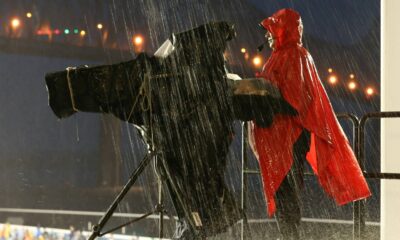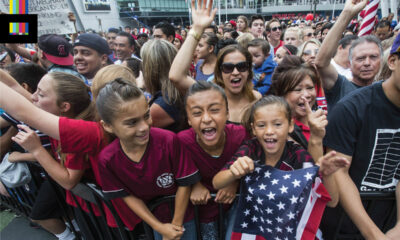On Monday, the Atlanta Silverbacks of the North American Soccer League (NASL) officially suspended operations for the 2016 season, and likely beyond. The Silverbacks’ suspension continues a pattern of instability in the US and Canada’s second tier. For this coming season, the NASL will have dropped two teams, Atlanta and San Antonio ,while adding teams in Miami and Oklahoma City. Puerto Rico will join the league the following season, which begins in July 2016.
The Silverbacks, which the league assumed control in late 2014, faced an uncertain future after Major League Soccer (MLS) announced plans to place an expansion team in the market. Following this announcement, the Silverbacks’ owners backed out of managing the club, which dates its history to 1995, leaving the league’s other owners to pick up the pieces.
The United States Soccer Federation (USSF) has sat by while the three professional leagues in the US and Canada have engaged in predatory practices for their own survival. While some critics of the North American soccer market claim it is the most tightly controlled and regulated on the planet, the opposite is in fact true. With no vertical integration in the pyramid and divisional designations largely meaningless, the leagues have engaged in a war against each other. Today a detente in terms of marketing relationships exists between the first-division MLS and third-division United Soccer League (USL), but the two leagues once had a similar arrangement that broke down over a decade ago. That breakdown ushered in an era of animosity, with MLS raiding the USL of some of its marque clubs.
Following this period, several USL clubs split of and created the NASL in 2009. At the time, the USSF tilted toward the NASL, as thanks to the generous financial backing of since disgraced Brazilian marketing giant Traffic Sports, they were looking to invest more heavily in Division 2 soccer. A brief detente between all parties existed in 2010 during the US’s 2022 World Cup bid, and NASL was promoted by the USSF as an example of the growing game in the country. When the US World Cup bid was defeated under suspicious circumstances by Qatar in Dec. 2010, all gloves were off, and the leagues resumed feuding.
At the time new standards were put in place to force the USL, which had been a Division 2 league, to move down to Division 3, leaving the NASL as the sole Division 2. Yet for the next two years, the USL’s official league boilerplate language referred to it being “the strongest and most experienced league below Major League Soccer,” implying the USL was a second division when it was not. The USSF choose to do nothing about this false claim.
In 2013, USL choose to pick a fight with the NASL in the Tampa-St. Petersburg media market. The USL startup club, which was much ballyhooed at the time and backed at least publicly by Premier League legends Ian Wright and Mark Hughes, flopped badly in competition with the NASL’s Tampa Bay Rowdies and, just 60 miles down the road, the USL’s own Orlando City club, who were preparing to make a move to MLS. When the USL invaded the NASL’s turf, the USSF sat silently by.
More recently, MLS has invaded an established NASL market in Atlanta without working with the existing Silverbacks ownership and attempted to put a team in Miami without working with the Fort Lauderdale Strikers. But this is a two-way street. Yesterday, it was announced former Chicago Fire President Peter Wilt was leaving his current team, NASL’s Indy Eleven to pursue the start up of a team in that league for the Chicago market.
SEE MORE: NASL team in Chicago wants to start at Solider Field, says Peter Wilt.
By most objective standards, the Chicago Fire are a blight on a growing MLS. The club may have enjoyed too much success, too soon in its early years, but since the move to the southern suburb of Bridgeview, the club has become an afterthought in the local sporting landscape. Now the NASL wants to invade what is a shaky market for MLS. US Soccer’s own hometown will become the latest frontier in this growing soccer war.
Still, the NASL’s Chicago team likely has no prospects of getting a stadium deal done within the city limits anytime soon, meaning the club is likely to play in rented facilities for years to come. The same can be said of the NASL’s efforts to put a team in various California markets where MLS already resides as well as Oklahoma City, where a quixotic startup associated with La Liga club Rayo Vallecano will play this spring in a rented facility outside of town, putting together a team at the last possible minute. Oklahoma City is the home of one USL’s more successful independent franchises, the OKC Energy, and this week around the MLS Combine the general sense among soccer people at all levels was the NASL was engaging in a mad pursuit by placing a team in a strong existing USL market.
Yet the USSF again seems to not have any interest in keeping the NASL out of a market where they are unlikely to succeed. In addition, the USL continues to play a similar game, having effectively flipped San Antonio from successful NASL market to USL startup this offseason, albeit in a roundabout way. Long-term ,this likely works out for the market, as the new San Antonio USL team has MLS ambitions. Still, the competition between leagues again fueled unnatural movement in the market.
Similar comments are being made about the new NASL team in Miami, though in fairness, it was MLS who initially invaded NASL’s turf in the Miami-Fort Lauderdale market. Now the NASL appears to be doubling down ,trying to create a “derby” locally before David Beckham’s proposed MLS team gets rolling.
All of this drama leads back to the USSF; the unwillingness of the federation to do anything that creates harmony or integration between the leagues. NASL’s pursuit of clubs in MLS markets when a number of strong open markets exist is mind-blowing, yet on a league-level, it makes sense. In a world without proper oversight, a league whose entire ownership pool save one has flipped since 2012 might be anxious to move into a large media market.
But what is best for the business of MLS or NASL is not necessarily in the best interests of American soccer. Unfortunately, the USSF — the designated safeguard of those interests — has been asleep at the wheel for years.
200+ Channels With Sports & News
- Starting price: $33/mo. for fubo Latino Package
- Watch Premier League, World Cup, Euro 2024 & more
Live & On Demand TV Streaming
- Price: $35/mo. for Sling Blue
- Watch Premier League, World Cup & MLS
Many Sports & ESPN Originals
- Price: $9.99/mo. (or get ESPN+, Hulu & Disney+ for $13.99/mo.)
- Features Bundesliga, LaLiga, Championship, & more
2,000+ soccer games per year
- Price: $4.99/mo
- Features Champions League, Serie A, Europa League & NWSL
175 Premier League Games & PL TV
- Starting price: $4.99/mo. for Peacock Premium
- Watch 175 exclusive EPL games per season
110+ channels, live & on-demand
- Price: $59.95/mo. for Plus Package
- Includes FOX, FS1, ESPN, TUDN & more























Heimdall
January 23, 2016 at 6:17 pm
Guard your grill, knuckle up and fight it out. Go forth and determine your best financial situation and be in the league that’s the best for your team’s future. Except for MLS teams, they aren’t single entity. Charleston and Richmond voluntarily relegated as they didn’t value the second tier designation in exchange for the relief of travel to the northwest hinterlands and closer neighbors. These leagues own the leagues not the teams. MLS has less spots and it’ll allow the other two pro leagues to concentrate on their long term expansion, but it should be no secret to them they they want the big markets and the lower level owners are voluntarily leaving for the better opportunity. I have no problem with this. I have no problem with USL and NASL invading each other and MLS being invaded by NASL. These cities are not protected markets so poach and expand.
People will vote with their dollars (both fans and investors) so just let the market sort itself out and it will increase soccer investment in between the MLS and amateur levels, where desire for teams exist, but not investment. If someone wants to invest in soccer, why stop them? Out of these attempts, the successes and failures will be noted and the next wave of investment will be surer. I don’t want a big investor who wants to do things the right way be discouraged to invest in his market or where s/he cares about or where the opportunity is and is shut out and then decides to invest in a different country.
Soccerreform
January 22, 2016 at 6:25 pm
Promotion and relegation solves this.
Full stop.
NaBUru38
January 13, 2016 at 11:54 pm
Competition is now a bad thing?
Soccerreform
January 22, 2016 at 6:27 pm
Competition should be between clubs, not leagues. This isn’t Coke v Pepsi or Burger King v McDonald’s or Walmart v Kmart or Red Lobster v Long John Silvers or even USFL v NFL. This is club soccer.
Eplnfl
January 13, 2016 at 5:04 pm
Kartik:
I must agree with you in part and disagree in part on your comments regarding Chicago.
I agree that even with the master hand of Peter Wilt involved getting a stadium built within the City of Chicago will be extremely difficult. It will have more to do with Chicago politics rather then the popularity of soccer in the Windy City. All soccer fans should hope Peter is a success here and I can not wait to attend the first match of the new Chicago Sting.
As to the Fire whom I have been a season ticket holder for and plan on remaining so the Bridgeview issue is a false one. People who come out enjoy the experience and given the terrible on pitch performance of the last few seasons the attendance is almost remarkable. Back in the day when the NHL Chicago Blackhawks had stone age management now apparently moved over to the Fire at least in spirit they would draw 10,000 fans. Now nose bleed tickets if you can find them can cost $200.00.
The stadium issue arose in my opinion only for management to cover their otherwise inept on the pitch performance. I can tell you as a Season Ticket Holder you are treated very well by Fire Ticket Reps. However winning on the pitch is everything. I strongly disagree with the notation that the Fire had too much success too soon. Peter Wilt worked hard to put together great talent and the money was there and the effort resulted in great performance with some outstanding players brought in. So far as the Fire is concerned if the front office and ownership get their act together and may be this new front office can produce Toyota Park will be filled to capacity which is only 20,000.
caps
January 12, 2016 at 9:55 pm
The article does not mention that Traffic Sports are the real criminals in this story and the US Dept of Justice, thinks so too, indicting the company and its chief officers for bribery and corruption Traffic Sports were also the owners of the Silverbacks and underwrote a good portion of the NASL finances. The Silverbacks should have been rolled up as son as the scandal broke. Instead the NASL kept it a float in hopes of new (and never forthcoming) owners. The NASL is a financial mess and carries with it, all the problems of the old NASL which folded because it’s owners wanted to buy the best foreign players it couldn’t afford. With no television or media rights income, low crowds, rented stadiums (does this sound familiar) it was only a matter of time before the owners, tired of the drain, gave up. This is the future of the “new” NASL.
The USL has developed, under it’s partnership with the MLS, strict accounting and fiscal measures to assure the well being of it’s teams, followers and fan base going forward. Last week, the Rochester Rhinos were taken over by the USL, when it’s owners did not follow the proper procedures and practices and lost their lease with it’s stadium. The Rochester Rhino’s were the newly crowned Champions of the USL. The Rhinos have a larger fanbase and attendance than some of the current NASL teams.
The article fail to mention that the NASL teams can get access to the to first division football and the MLS, all they need to do is pony up the franchise fee and a stadium guarantee and be awarded a franchise. Thinking they have earned a right to be first division by defeating other 2nd division teams and offer no economic security is foolhardy.
The MLS has followed the lead of all of the other major US sports leagues, in that hey have adopted a franchise model. So far, it looks like a success, while this was never pre-ordained, the model has been attributed to its survival and success and part of that model has been adopted by the new USL.
The European system, adopted by many leagues the world and which the NASL runs under is predicated on promotion of teams who put money into the team, acquire player rights and transfers to be sold for profit and income, a large supporting fanbase, local media rights, and access to a cheap (not expensive) supply of experienced good players.. The fact that many of these factor are not, nor will be, available to the NASL should be noted.
As with the electrical appliances and their plugs that use different power needs bought in Europe, they do not work when brought to the US. That is unless you buy an adapter. The NASL and its pundits need to adapt, or they will go the way of the old NASL.
Tim
January 13, 2016 at 11:54 am
Stop making sense….There is no place for that here.
Eric
June 1, 2016 at 5:27 pm
Rented stadiums can be a boon for NASL teams, which lack billionaire franchise owners keen to insulate themselves from a performance-based system. (Ooh, I used a British word, keen–maybe I can call a soccer field a football pitch next!) For example, playing on a campus with thousands of foreign students and within walking distance of a hipster-inhabited downtown has proven to be a winning formula for Indy Eleven. Of course, ironically said downtown was built on the survival of a 1 cent tax for a football stadium long since paid for and torn down (No, not a “pitch”–that’s what a pitcher throws in baseball). Speaking of baseball, when the MLB Pittsburgh Pirates were flagging, their farm team, the AAA Indianapolis Indians, sometimes rivaled them in attendance. They, too, have a central location with plenty of nearby and cheap ($3) underground parking provided by the downtown mall. If this is “second tier” give me more! I’ll shut up now. If I say more, MLS or MLB might come calling and ruin a good thing.
Paulo
January 12, 2016 at 9:54 pm
All the problems in North American soccer, be it the USSF, the CSA, NCAA’s, Nasl, Usl, etc can be traced to weak or absent ( or both) leadership that in the end, has money and the protection of personal and petty turf fights stagnating the potential of the sport. There are plenty of problems in other parts of the world regarding futbol, but there is no denying that actions are taken for the love of the game rather than solely focused on private profit or control. More brave writers and reporters need to comment on this matter rather than spew catch phrases and marketing dross that administrators of said leagues want spread to key demographics and consumers.
seth Israel
January 12, 2016 at 9:49 pm
Excellent article, finally something Kartik and I agree upon. This story should be front page with Mr. Sunil face splattered all over. We need to demand the resignation of Mr. Sunil as this systemic institutional corruption which includes monopolistic powers back by MLS marketing money now jeopardizes the allocation of resources crucial to the future development of US Soccer.
Kevin Villegas
January 12, 2016 at 4:42 pm
There are two problems.
1, Everyone thinks they are going to rich off of soccer in this country, to the detriment of the actual sport. That causes every Tom, Dick or Harry to come out of the woodwork to create their own club, shop, camp, whatever. Most of them are in it for the supposed money and only a select few of them honestly care about the state of the game in the US. What they fail to realize is that there isn’t much money to be made outside of the big markets. You can see this same thing at work when you realize the number and quality of soccer ‘writers’ on sites like Bleacher Report, Soccer NewsDay, BigSoccer.com and SBNation blogs. Everyone thinks they’ve stumbled across something new in soccer. They haven’t. They all tire of soccer after they realize that no one cares about their camp or club or blog.
2, The USSF has a real problem with leadership. Say what you will about MLS and USSF being in cahoots, or Sunil Gulati being on the ExCo. The issue is USSF cannot or will not control soccer in the United States. That is a failure of leadership. The problem is not too difficult to solve – it is simply too difficult for the current USSF leadership to solve.
And here we are with the issue. The USSF doesn’t care about the NASL because it’s not making them any money. But the USSF doesn’t care enough about the USL (who is really in bed with MLS) because they’re not making them enough money. So the fighting continues. And NASL clubs and USL clubs and alleged ‘clubs’ suffer because of the lack of clarity.
The old saing goes “If it’s not making me happy, and it’s not making me money, I’m not doing it.” That’s USSF’s attitude and it shines though in everything they do.
alex gago
January 12, 2016 at 4:33 pm
Exactly analysis MLS strategy is anti competitive. They control USSOCCER Federation by virtue of money, making USSOCCER federation corrupt as their. Interest lie only in MLS and not in the best interest of US Soccer. I call on a full investigation be launched by the justice department and call for Sunnil to step down. Lets not be naive soccer fans.
PLJS
January 12, 2016 at 3:23 pm
An absolutely brilliant piece about the biggest problem in our game right now. You could have even taken this a step further and brought in the PDL, NPSL, PLA and other 4th / 5th division leagues (where again, pyramid designations mean little). There is so much in-fighting that it’s hard for any sustained success. We need a formal structure, and although it’s a debate I hate to jump into, probably real promotion and relegation talks. Otherwise, this circle simply continues as the USSF stands idly on the sideline.